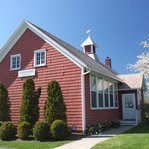What's in a name?
"Apple Pie." "Harmony." "Frog Pond." "Puckerbush." "Peach Valley." "Barefoot Nation." "White Eagle." "Excelsior."
Each of these names belongs to a one-room schoolhouse that has graced the American landscape spanning centuries. Many are mere memories today. Others, like The Sagaponack School on outer Long Island, are very much with us.
Sagaponack has been called "a hidden gem in the Hamptons."
The school is a snug, red building that dates back to 1885. There are still vestiges of bygone days - among them, an old wood burning stove and historic wooden desks with past students' names etched in the surfaces.
"You can tell a kindergarten desk because it is the smallest and does not have a hole carved out of it for an inkwell," explains Aimee Campbell, in her first year as Sagaponack head teacher.
Before coming to the school, Ms.Campbell taught elementary and multi-grades. She feels her Master of Arts in Archeology from Washington State University has stood her in good stead toteach in Sagaponack's unconventional environment.
Contrary to conventional impression, Sagaponack is not a museum. It is a fully functioning school serving 12 children grades one through four.
Says Ms. Campbell, "It really feels more like a house than a school at times, and one of our little first graders even calls it 'home.'"
"...Sometimes I'm a teacher, sometimes a crossing guard, nurse, secretary. And the students each have weekly rotating jobs - to make our school run smoothly. We even have a job to ring the bell in the bell tower mornings and afternoons.
"By working closely together, the morale of the school is high because we all have a vested interest in the success of our students and the continuing legacy
of the school.
"On occasions, our students are encouraged to teach the class as a reward for good behavior. They take on the role of teacher and choose a topic to teach a small group of students.
"Teamwork," Ms. Campbell continues, "is not only encouraged, but necessary. Students can be creative, follow their own interests and learn to their fullest potential in a supportive, caring environment in which everyone is accepted, celebrated.
"We're like a family, so connected."
Sensitive oversight, she adds, "is crucial in early detection of social, emotional, physical, and psychological changes in our students. When we see a problem or change, we can address it immediately before it escalates."
The poet Emily Dickenson once rued, "We have the facts, but not the phosphorescence of thought."
At Sagaponack there is clearly phosphorescence of thought, part of the school's stellar heritage,
Yes, there are some standardized tests and grades as in usual learning settings.
But there's more.
There is peer teaching wherein older students effectively coach younger ones. This arrangement reaches back generations - quite literally, "old school."
There is active parental involvement, well beyond the usual.
"My daughters had a chance to shine there," says Deborah Quimby, parent of two recent Sagaponack School graduates. "No one gets lost in the cracks. There's no exclusion, no bullying."
Anne, her ten year old daughter, now attends a standard public school in the Hamptons.
"I'm doing well but I like Sagaponack better," she confides. "It was small, easier for kids to learn."
Diane Ravitch is a prominent voice in American education reform. Dr. Ravitch has written, "Genuine school reform must be built on hope, not fear; on encouragement, not threats; on inspiration, not compulsion; on trust, not a slavish devotion to data; on support and mutual respect, not a regamin of punishment and blame."
And so, we discover antidote in Sagaponack and in the one-room concept overall. A preventative lesson perhaps, drawn from schools like Columbine, Everett, Newtown, Sandy Hook and the nearly 100 other shooting sites all too present in recent years.
Suppose a more vigilant core of guidance counselors could have staved off any of these tragedies. Suppose a more nurturing interface between children, educators and families could lift conditions that underlie such killings.
The accomplished musician/fine artist Tony Bennett, of all people, recently spoke of "the art of intimacy." Could the Sagaponack prototype assure the safety of our young people?
Neil Twitchell attended a Nevada one-room schoolhouse during the 1920s. Looking back, he recalled, "By far the most important part of my experience was the closeness of the whole community.





















